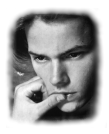

This
article was written by Rachel, from a website called 'Applying
Psychology to the 'Real World'', I think it's a very
helpful article if you are trying to come to terms with
or understanding what happened to River and why he couldn't
have helped himself recover from his drug additions.
Rachel,
however, does not state her sources in some of the claims
she makes, but they appear to have been taken from John
Glatt's biography of River.
In the early hours of October
the 31st, 1993, actor River Phoenix collapsed into drug
induced seizures on the footpath of the Los Angeles nightclub
'The Viper Room'. The 23 year old was to subsequently die
of cardiac arrest after being rushed to the emergency ward
of a local hospital.
What followed was rumour
and speculation as to the type, and intensity, of the drugs
River had consumed prior to his death. This speculation
extended beyond the activities of the morning of October
31, including theories on River's drug past. These reports
were as contentious and as vague as those dealing with his
death. Three years on, the evidence is little clearer, although
it is certain that Phoenix had been exposed to drugs long
before that fatal Halloween night.
It is believed that the mix
of drugs consumed by River Phoenix on the night before his
death consisted of Valium, Marijuana, toxic levels of Cocaine
and Heroin
and a substance known as G.H.B
or Grievous Bodily Harm. These drugs were taken both at
the Viper Room, and in Phoenix's hotel room, where his girlfriend
had organised a reunion with his brother and sister who
he hadn't seen in some time. In contrast, River's drug history
is less clear, although as diverse as the range of substances
he was suspected to have used.
The earliest reports date
Phoenix's first use of Cocaine in 1987, the year he filmed
'Running on Empty'.This year also signalled his move to
Micanopy, Gainsville, where he set up house which many described
as a commune. River's home was constantly full of people
who he would continually entertain with his music, and 'new
age' philosophies and also, it is believed, his drugs- primarily
Cocaine,
Peyote
and Psycedelic
Mushrooms.
Phoenix's use of Cocaine
continued through to 1990 when he began working on the Gus
Van Sant film, Heroin. This discovery continued into 1991
until fellow cast member of the film 'Sneakers', Dan Ackroyd,
expressed his concerns about the seriousness of River's
drug habit, to him. While promising to curtail his addiction,
Phoenix arrived at a friends home in 1992 'speedballing'
on a mix of Cocaine
and Heroin,
where he passed out, again promising to seek help.
This time however, the promise
was more seriously kept, and it is stated that from August
of 1993, soon after his 23rd birthday, Phoenix stayed sober.
The night of the 30th of October signalled his first return
to drugs for almost two months. It must be noted however,
that some cast members of the movie he was currently filming,
'Dark Blood' , observed River arriving on the set looking
'high'.
This is supported by the reports
of Valium in Phoenix's blood on the night he died, which
he had reportedly been consuming during filming due to clashes
between himself and other cast members. Solomon and Corbit
(1974) propose the Opponent
Processes Theory which discusses the conditioning to
an opponent process of an emotional response.
They maintain that drug addiction
is one such response. River Phoenix's abuse of Cocaine
and Heroin,
and particularly his continued use of Valium, in order to
feel 'normal', seems to support their theory that the continued
use of drugs will diminish the pleasant effects and thus
act only to quell the negative ones. Similarly, Shepard
Siegal (1983), discusses drug tolerance, and dependence,
in regards to classical conditioning.
In particular he believes
that the environmental cues preceding drug use play a major
role in addiction. The comfortable, pleasant, family-like
surroundings of Micanopy, when Phoenix' s drug use became
established, was replicated several times, e.g. Gus Van
Sants home, and the hotel room on the night he died, thus
lending support to the theory, and providing an explanation
to the difficulty River experienced when attempting to 'kick'
his addiction.
END OF ARTICLE
We
could have just provided a link to this article to it's
orginal source - but we have chosen to copy it in case it
is later removed from that said website. © always remains
with the author.
|
